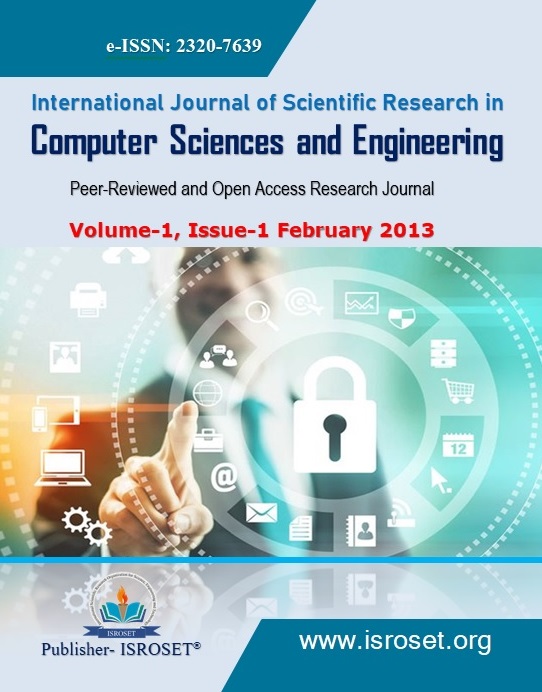Security Enhancement in Cloud Computing (CC)
Keywords:
Cloud Computing, Security Model, PrivacyAbstract
Cloud computing (CC) is set of resources and services offered through the Internet. Cloud services are delivered from data centers located throughout the world. Cloud computing facilitates its consumers by providing virtual resources via internet. CC is becoming one of the most important areas in the Information Technology world. Several issues and challenges are being raised from the adoption of this computational paradigm including security, privacy and authentication and association. In this paper aims to introduce new security ideas in cloud computing. In this paper, we describe the specifics of cloud computing, we address the principal security issues for cloud computing and we discuss primary cloud operations that need to be secured and we discuss the data security based model for cloud computing. We identify the new challenges and opportunities posed by this new cloud computing environment and explore approaches to secure its communication.
References
Ricardo vilaca, Rui oliveira, “Clouder : A Flexible Large Scale Decentralized Object Store. Architecture Overview”, Proceeding of WDDDM, 2009.
Michael Miller, “Cloud Computing-Web Based Application that change the way you collaborate online”, Publishing of QUE, 2nd print 2009.
Shivlal Mewada, Umesh Kumar Singh and Pradeep Kumar Sharma, “Security Based Model for Cloud Computing”, IRACST-International Journal of Computer Networks and Wireless Communications (IJCNWC), Vol. 1, No. 1, 2011.
Wayne Jansen, Timothy Grance, Guidelines on Security and Privacy in Public Cloud Computing, NIST, Draft Special Publication 800-144, January 2011 http://csrc.nist.gov/publications/drafts/800-144/Draft-SP-800 144_cloudcomputing.pdf
ENISA, Cloud Computing: Benefits, Risks and Recommendations for information Security, November 2009 http://www.enisa.europa.eu/act/rm/files/deliverables/cloud-computingrisk-assessment/at_download/fullReport
The NIST Definition of Cloud Computing, version 15, by Peter Mell and Tim Grance, October 7, 2009, National Institute of Standards and Technology (NIST), Information Technology Laboratory (www.csrc.nist.gov )
S. Subashini, and V. Kavitha. (2010) “Asurvey on security issues in service delivery models of cloud computing.” J Network Computer Application doi:10.1016/j.jnca.2010.07.006. Jul., 2010.
M. Klems, A. Lenk, J. Nimis, T. Sandholm and S. Tai. “What’s Inside the Cloud? An Architectural Map of the Cloud Landscape.” IEEE Xplore, pp 23-31, Jun. 2009.
R. Woolley and D. Fletcher “The Hybrid Cloud: Bringing Cloud-Based IT Services to State Government October 4, 2009” Department of Technology Services.
T. kraska “Building Database Applications in the Cloud” Swiss federal institute of technology Zurich 2010
Global Netoptex Incorporated , 2009, Demystifying the cloud. Important opportunities, crucial choices, http://www.gni.com , pp 4-14, viewed 13 December 2009.
Security Guidance for Critical Areas of Focus in Cloud Computing, April 2009. DOI = http://www.cloudsecurityalliance.org/topthreats/csat reats.v1.0.pdf
ISO. ISO 7498-2:1989. Information processing systems- Open Systems Interconnection. ISO 7498-2
Dlamini M T, Eloff M M and Eloff J H P, ‘Internet of People, Things and Services – The Convergence of Security, Trust and Privacy’, 2009.
Siani Pearson. Taking Account of Privacy when Designing Cloud Computing Services. CLOUD 09: Proceedings of the 2009 ICSE Workshop on Software Engineering Challenges of Cloud Computing, pages 44-52. May 2009.
Discovering Identity: Cloud Computing: Identity and Access Management DOI = http://blogs.sun.com/identity/entry/cloud_computing_identity_and_access
Worldwide Infrastructure Security Report, Arbor networks, 2010 http://www.arbornetworks.com/dmdocuments/ISR2010_EN.pdf
Dai Yuefa, Wu Bo, Gu Yaqiang, Zhang Quan, Tang Chaojing, “Data Security Model for Cloud Computing” Proceedings of the 2009 International Workshop on Information Security and Application (IWISA 2009) Qingdao, China, November 21-22, 2009 (ACADEMY PUBLISHER AP-PROC-CS-09CN004)
Downloads
Published
How to Cite
Issue
Section
License

This work is licensed under a Creative Commons Attribution 4.0 International License.
Authors contributing to this journal agree to publish their articles under the Creative Commons Attribution 4.0 International License, allowing third parties to share their work (copy, distribute, transmit) and to adapt it, under the condition that the authors are given credit and that in the event of reuse or distribution, the terms of this license are made clear.







